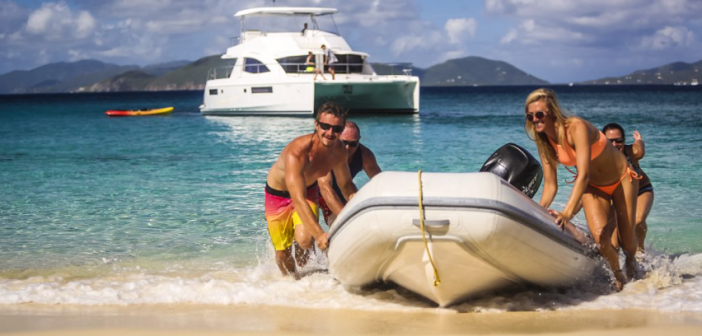Here’s a basic primer with solid information about how to choose the best RIB or tender for your cruising boat. It was written by Keith McVeigh for Leopard Catamarans, but the information applies to all cruising boats, and it might help you make an informed decision.
By Keith McVeigh
You’ve bought your boat. But now you need a boat for your boat. A yacht tender is a vital part of any yacht– it is your ticket to freedom.
Instead of being confined to marinas, a tender provides you the luxury to drop anchor, and still have access to all of the places on land that you would like to go. Avoid crowded marinas, enjoy the ocean breeze, and sleep in peace. Plus, if you are not a catamaran docking master just yet, you can avoid putting on a show for the whole marina to see.
Not only are tenders a thrill to zip around in, they are a practical piece of equipment and something that will be considered during your yacht purchase.
What is a RIB?
Rigid inflatable boats (RIBs) are generally the first choice of cruisers because of the many benefits they offer owners. These are inflatable tenders with rigid hulls, which provide the performance and strength of a solid boat. The hulls are typically made of fiberglass or aluminum, which allow you to cruise through chop, but you’ll probably want to hold on tight. Another added bonus to a RIB is the inflatable tubes on the topsides, which help avoid abrasions to other vessels (and your vessel) when approaching as they provide a fender-like support system.
This type of tender is hard to tip over and can be loaded with many people, toys and provisions. Among all of the other tenders they are very maneuverable and, when in a busy marina, they are easy to pull in, as the inflatable hull will not damage other tenders when bumping your way in. The rigid hull also makes it easier to pull onto a sandy beach. Don’t forget your tender anchor to stop the tender from drifting off when the tide comes in.
Size, bottom material and engine selection
Size and weight are always a trade-off. Sure, you can get that 12 foot dinghy to load up with provisions, but you must also consider that if it is just a party of two pulling up to the beach, you may have a difficult time beaching the boat.
Your choices for the bottom of your RIB are either aluminum or fiberglass. While aluminum is lighter and more durable, a fiberglass hull is quieter and steadier.
Another thing you will consider when choosing your RIB will be the addition of an outboard. Some of the most popular engines on the market are Yamaha, Suzuki, Honda and Mercury. Outboards can range from 3-6 HP, but for those cruisers who have a need for speed (and enjoy being on plane) your best option will be somewhere around 8-15 HP. Read more:
https://blog.leopardcatamarans.com/selecting-the-right-tender?fbclid=IwAR0PvcNjYWUWoJ_MJPIxQ00rkaHtLWUyULo55YYomJs3ORienFPTgdV_gDI




